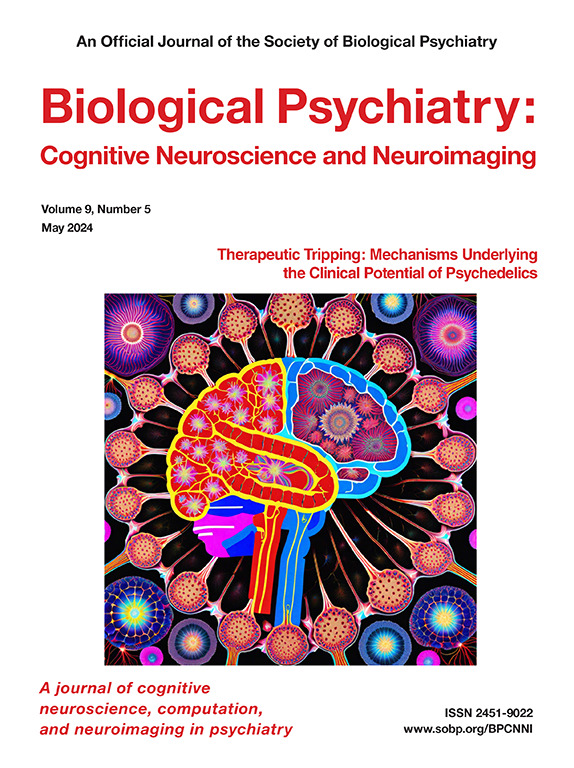Transfer Learning of Deep Neural Networks Pretrained Using the ABCD Dataset for General Psychopathology Prediction in Korean Adolescents
IF 4.8
2区 医学
Q1 NEUROSCIENCES
Biological Psychiatry-Cognitive Neuroscience and Neuroimaging
Pub Date : 2025-09-01
DOI:10.1016/j.bpsc.2025.04.005
引用次数: 0
Abstract
Background
In this study, we examined whether a deep neural network (DNN), trained to predict the general psychopathology factor (p factor) using functional magnetic resonance imaging (fMRI) data from adolescents in the ABCD (Adolescent Brain Cognitive Development) Study, would generalize to Korean adolescents.
Methods
We trained a scanner-generalization neural network (SGNN) to predict p factor scores from resting-state functional connectivity (RSFC) data of 6905 ABCD Study adolescents, controlling for MRI scanner–related confounds. Then, we transferred the pretrained SGNN to a DNN to predict p factor scores for 125 adolescents, including healthy individuals and individuals with major depressive disorder, using data from Seoul National University Hospital (SNUH). We compared the transferred DNN’s performance with that of kernel ridge regression (KRR) and a baseline DNN.
Results
The transferred DNN outperformed KRR (0.17 ± 0.16; 0.60 ± 0.07) and the baseline DNN (0.17 ± 0.16; 0.69 ± 0.11), with a higher Pearson’s correlation coefficient (0.29 ± 0.18) and lower mean absolute error (0.59 ± 0.09; p < .005). We identified the default mode network (DMN) and visual network (VIS) as crucial functional networks for predicting p factors across both datasets. The dorsal attention network was specific to the ABCD Study dataset, while the cingulo-opercular and ventral attention networks were specific to the SNUH dataset.
Conclusions
The transferred SGNN successfully generalized to Korean adolescents. Altered RSFC in the DMN and VIS may serve as promising biomarkers for p factor prediction across diverse populations, addressing heterogeneity in demographics, diagnoses, and MRI scanner characteristics.
使用ABCD数据集预训练的深度神经网络迁移学习用于韩国青少年一般精神病理预测。
背景:本研究探讨了深层神经网络(DNN)是否可以在青少年大脑认知发展(ABCD)研究中使用功能磁共振成像(fMRI)数据来预测一般精神病理因素(p-因子),并推广到韩国青少年。方法:在控制MRI扫描仪相关混杂因素的情况下,我们训练了一个扫描仪-概化神经网络(SGNN),从6905名ABCD青少年的静息状态功能连接(RSFC)数据中预测p因子得分。然后,我们使用首尔国立大学医院(SNUH)的数据,将预训练的SGNN转移到DNN,以预测125名青少年的p因子得分,包括健康个体和重度抑郁症患者。我们将转移的深度神经网络的性能与核脊回归(KRR)和基线深度神经网络的性能进行了比较。结果:转移DNN优于KRR(0.17±0.16;0.60±0.07)和基线DNN(0.17±0.16;0.69±0.11),Pearson相关系数较高(0.29±0.18),平均绝对误差较低(0.59±0.09);P < 0.005)。我们确定默认模式网络(DMN)和视觉网络(VIS)是预测两个数据集p因子的关键功能网络(FNs)。背侧注意网络是ABCD所特有的,而扣带-眼和腹侧注意网络是SNUH所特有的。结论:转移的SGNN在韩国青少年中推广成功。DMN和VIS中RSFC的改变可以作为不同人群p因子预测的有希望的生物标志物,解决人口统计学、诊断和MRI扫描仪特征的异质性。
本文章由计算机程序翻译,如有差异,请以英文原文为准。
求助全文
约1分钟内获得全文
求助全文
来源期刊

Biological Psychiatry-Cognitive Neuroscience and Neuroimaging
Neuroscience-Biological Psychiatry
CiteScore
10.40
自引率
1.70%
发文量
247
审稿时长
30 days
期刊介绍:
Biological Psychiatry: Cognitive Neuroscience and Neuroimaging is an official journal of the Society for Biological Psychiatry, whose purpose is to promote excellence in scientific research and education in fields that investigate the nature, causes, mechanisms, and treatments of disorders of thought, emotion, or behavior. In accord with this mission, this peer-reviewed, rapid-publication, international journal focuses on studies using the tools and constructs of cognitive neuroscience, including the full range of non-invasive neuroimaging and human extra- and intracranial physiological recording methodologies. It publishes both basic and clinical studies, including those that incorporate genetic data, pharmacological challenges, and computational modeling approaches. The journal publishes novel results of original research which represent an important new lead or significant impact on the field. Reviews and commentaries that focus on topics of current research and interest are also encouraged.
 求助内容:
求助内容: 应助结果提醒方式:
应助结果提醒方式:


